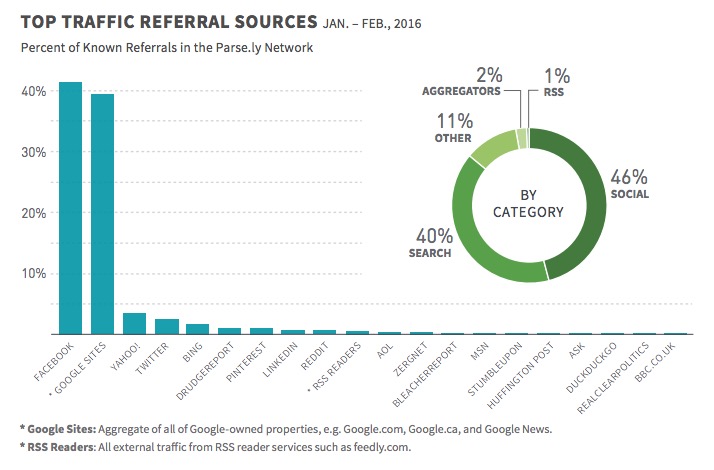 Twitter generates 1.5 percent of traffic for typical news organizations, according to a new report from the social analytics company Parse.ly that examined data from 200 of its client websites over two weeks in January. (You’ll need to give Parse.ly your email address to access the full report.) Parse.ly’s network includes publishers like Upworthy, Slate, The Daily Beast, and Business Insider.
Twitter generates 1.5 percent of traffic for typical news organizations, according to a new report from the social analytics company Parse.ly that examined data from 200 of its client websites over two weeks in January. (You’ll need to give Parse.ly your email address to access the full report.) Parse.ly’s network includes publishers like Upworthy, Slate, The Daily Beast, and Business Insider.
The median publisher saw roughly 8 tweets per post, 3 clicks per tweet, and 0.7 retweets for each original tweet, Parse.ly said. The top five percent of publishers performed better on Twitter, averaging 11 percent of their traffic from the network.
(We here at Nieman Lab are among those outliers, not least because our audience is made up of digitally savvy journalists — a prime Twitter demo. During the first three months of 2016, about 15 percent of Nieman Lab’s traffic came from Twitter.)
The key to success on Twitter — and social media in general — is to know what your audience “finds interesting and make sure that you are creating content that reflects this,” the company said:
There is no “secret sauce” for digital publishers looking to improve their success on Twitter. Sites that are doing well on the platform — achieving high levels of engagement — are not necessarily the most active; rather, they are sites that are producing interesting and shareable content that appeals to a large number of people.
There are two main types of posts on Twitter, Parse.ly says: conversational news and breaking news:
Typical content on Twitter tends to be conversational in nature, with thousands of people engaging with a particular topic for an extended period of time. Breaking news stories, on the other hand, often drive large spikes in traffic over shorter periods of time.
The 2016 presidential election is an example of a conversational topic that generates ongoing reporting and discussion. In March, there were 1.9 million tweets with links to news coverage about the race in its network, the company said. Election tweets made up more than 6 percent of all the tweets Parse.ly studied in March.
Last month’s terrorist attacks in Brussels, meanwhile, demonstrated how breaking news spreads on Twitter. More than 92,000 tweets with links to stories on the attacks were posted within the first 24 hours after they occurred, according to Parse.ly’s data. About a third of those tweets were sent within the first six hours after the attacks.

Despite its conversational and breaking news value, Twitter remains a relatively small source of traffic for most publishers. According to Parse.ly, less than 5 percent of referrals in its network came from Twitter during January and February 2016. Twitter trails Facebook, Google, and even Yahoo as sources of traffic, the report said (though it does edge out Bing!):

“Though Twitter may not be a huge overall source of traffic to news websites relative to Facebook and Google, it serves a unique place in the link economy,” the report said. “News really does ‘start’ on Twitter.”